A quick note on this: I originally wrote this with the intention of turning it into a YouTube tutorial, back in like 2018. The YouTube channel never came to fruition, but I felt this was valuable for anyone who may just be starting their journey. There is a REAL pitch I share with you towards the end, but I encourage you to read through the whole thing, as any pitch will be improved by the juicy details.
Today I’m going to share with you exactly how to get started as a freelance writer using a special process that allowed me to scale from writing blog posts for $150 a pop, to landing a retainer at a major agency, making upwards of $5K a month allowing me to quit my 9-5.
And exactly how YOU can use the same process to get clients quickly, even if you’re just starting out.
So here’s the thing: when we’re all just starting out, we suffer from what’s called “The Novice’s Dilemma” and that is:
How Do You Become A Copywriter And/Or Freelance Writer With No Experience?
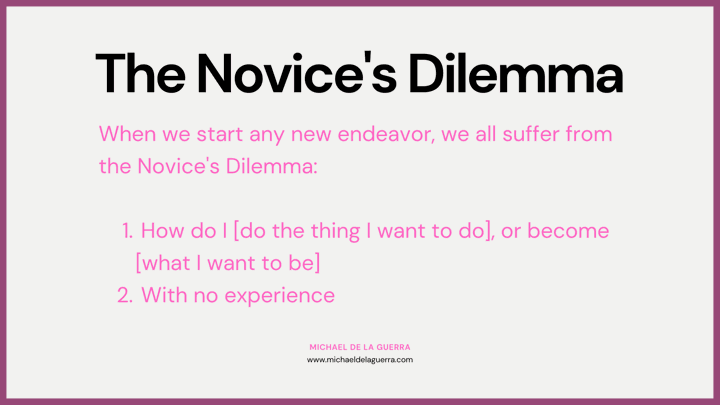
And that’s the beauty of the step-by-step process I’m going to share with you today: it’s going to help you get over this obstacle quickly, because if you want to:
- Get more writing clients (if you even have any at all)
- Get paid more from your writing
- Eventually make a full-time living from your writing
You’re going to need to do just a few things to get up and running, and today I’ve got just the thing for you.
Now let’s very quickly take a look at The Novice’s Dilemma. You’ll notice that are two parts to it:
1. How do you become a copywriter
2. With no experience
These are both big hurdles we need to get you over, so we have to diagnose each part. This process will address each part of this dilemma.

Step One: Your Freelance Writing Specialization and Niche
Now I’m going to show you exactly how to pick a profitable niche in just a second, but first I want to cover what most people think they should do, and what other online experts say you should do.
Usually you might think that you should generalize to cast a wide net and take any work you can get. No. Please don’t do this. You’ll save much more time if you specialize, and you’ll be able to better articulate your value to someone when you show that you do specialize in a certain niche.
Most other people will tell you to do something you’re familiar with, and this is good advice, BUT…
There’s more to it than that.
Specialization is a specific area of work that you’d like to concentrate on. You can go a few layers deep within different sub-specializations, so, for instance, let’s say you want to specialize in “content writing,” you could specialize in blog content, white papers, longer form ghostwriting jobs like books, etc.
If you’re a copywriter, you can specialize in FB advertising, sales copy, email copy, etc.
Make sense?
Coming up with a specialization will require two things: looking at what you like to do, and what you’re good at.
The intersection of these will be a good place to start when it comes to picking a specialization.
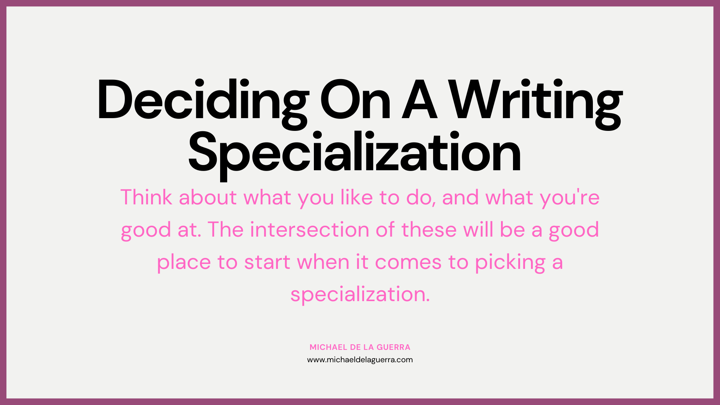
For me, I like long-form storytelling, so I usually work with big projects like sales webinar funnels, long-form sales letters, and projects that are more dense.
What No One Tells You About How To Choose A Copywriting Niche
Now a niche isn't what most people believe it to be.
While it's technically a small area of the market where you practice your specialization, a niche is a group assembled around a very specific set of needs.
It's less about who they are (which is important) and more about how you can help them.
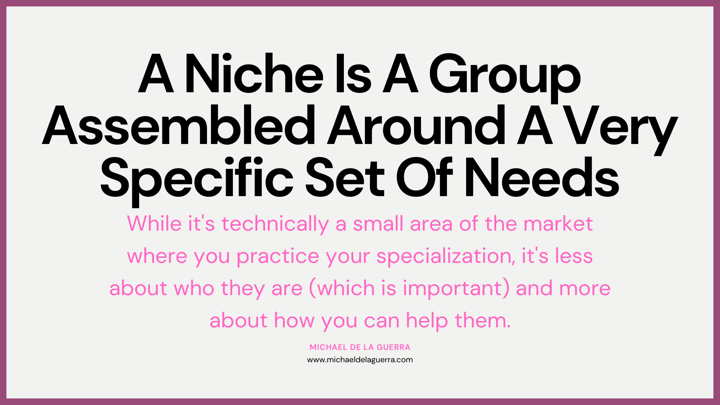
So if you wanted to find a profitable freelance writing niche, and your specialization is SEO-driven blog posts let's say, maybe you decide on the pet food niche.
Or you’re a copywriter who specializes in long-form sales letters for the health market.
Finding a profitable freelance writing niche will take a bit of work, but just like specialization a good place to start is the intersection of what’s profitable, and what you’re knowledgeable about.
And knowing how you can meet the demand of that niche's needs.
The pet food people for example: they of course want more traffic and sales from the content you create for them, but what do they need?
Perhaps they need to stay relevant and differentiate themselves in a market that's constantly coming up with different ways to sell processed slop.
Or maybe they need to find a way to compete with large brands and sites that can churn out more content in a week than they can in a month.
Understanding the needs of a niche means being able to tell that pet food person, "Hey, I know it's difficult to stand out in your market, and you're up against massive brands who pay bad writers a few cents a word to write mediocre articles, but we can outmaneuver them and stand out if we focus on leveraging the assets you've already got. Let's se how we can make it happen."
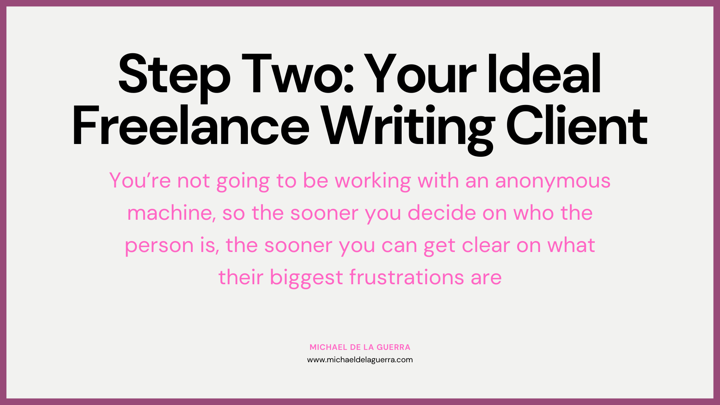
Step Two: Your Ideal Freelance Writing Client
Now almost every beginner misses this, but it’s helpful to know because it will guide you as you pursue clients with your newfound specialization and niche.
Figuring out who your ideal client is just means asking yourself:
What does my ideal client look like?
Who are they?
Are they the marketing heads of IT companies who need a good writer to help them generate leads through educational content?
Are they self-help influencers who need sales copy written for their next launch?
Define this person.
You’re not going to be working with an anonymous machine, so the sooner you decide on who the person is, the sooner you can get clear on what their biggest frustrations are—which is what we’re going to use to position you as an expert.
One thing to remember is that you’re never going to have the “perfect” client. But the closer you are to finding someone that’s perfect, the better off you’ll be. At the copywriting agency I work for, Conscious Copy, we only work with a specific kind of person. If you don’t meet certain qualifications, we won’t work with you. That’s because we have our ideal client dialed in.
Your ideal client should have at least two things:
- The willingness to pay for your services, and
- The ability to pay
Here are a couple examples.
Ideal Freelance Writing Client Example #1:
My ideal client is an IT company that markets itself to financial institutions via case studies and white papers.
Ideal Freelance Writing Client Example #2:
My ideal client is an online entrepreneur making six-figures or more who needs copy written to sell their info products.
Okay, so we've walked through the process of figuring out what you should be doing, and for who. If you’ve defined your specialization and niche, and your ideal client, then all you need to do is go out and show them you can help them. But first…
The next step in the process is to get your portfolio together.

Step Three: Your Freelance Writing Portfolio
Now I’m going to be honest...
I was hesitant to put this step in here. I got started without a tangible portfolio and I don’t want this idea of needing a large portfolio to knock you off track.
There are a few ways you can go about building one when you don’t have any experience.
But honestly, the trick when you’re first starting out is to focus ONLY on what’s going to put dollars in your bank account, which is going to be pitching clients—which I’m going to show you how to do in a moment.
Spending too much time on this will distract you from getting clients. Like I said, when I first started, I didn’t really have much of a website, portfolio, or very many samples.
But I landed a few clients because I knew my market well and my pitching skills were sharp.
That being said, a website at this stage isn’t necessarily a bad choice, some people just get lost trying to build one and stop themselves from moving forward because they get overwhelmed.
So, with that being said, here are a few ways to build your portfolio when you have little to no experience.
The first way to do it is to build a makeshift portfolio in Google Docs. Basically you create a document like this, with all of your relevant writing samples, your experience, etc, and that acts as your first hub:
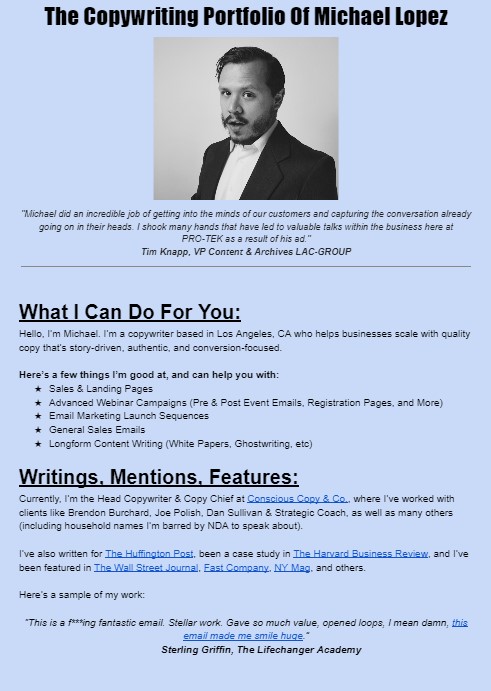
For those of you looking to pitch publications, to write things like articles, essays, columns, etc, you can use Contently.
And if you don’t have writing samples, that’s okay, but you should create some.
You can use Medium or your own website, OR you can even type up articles in Google Docs, edit them, save them as PDFs and add them to your Google Portfolio Hub (this is what I did when I had nothing to show).
What Kinds Of Freelance Writing Samples To Write
Don’t know what to create for a writing sample?
Well, that’s why we walked through the previous steps, because when you follow this process, at this stage you should know your niche and specialty, and you can begin writing specifically for your specialization, niche, and ideal client.
So you should know EXACTLY what types of pieces to create. Make sense?
Good.
Let’s say you’ve picked a niche, and now you need topics. Here’s what you do. Google what’s trending in your industry and go create samples based on that. I want you to be super vigilant with your research work, look for common themes in the area you want to work in, and create valuable pieces of content. I want you to write a piece of content so good that you know when you go to pitch a client, they’re going to want to pay you for it right there on the spot. Approach all your pieces this way.
And one more thing: DO NOT PLAGIARIZE.
I’ll do a video on how to create portfolio pieces in the future, but this is super important. Create brand new, unique pieces of writing that add value without ripping people off. If you want to work for B2B technology firms, and there’s a listicle or research paper that’s popular, add a unique twist to it or make it more valuable by adding more GOOD information to it.
If you’re an essayist, columnist, or someone who wants to write more expressive pieces in major publications, or even if you want to do a bit of journalism, the same applies here—go to the places you want to publish your writing in and look at what they’re putting out.
Create samples like that, and yes, it’s okay if they’re on your personal blog or Medium site.
Go look at writers you admire, see where else they’re publishing, then look at what kinds of content they put there.
What’s true across different writing modalities is that you have to know what your future clients want. When you understand EXACTLY what the people who will pay you money for your writing want...
You can pitch them your services.

Step Four: Pitching Your Freelance Writing Clients
Ok, you’ve done all that, now you’re ready to get clients. It’s time to pitch.
This is the second most important part of the process after niche selection.
Why?
Because if all you did was nail a profitable niche, reach out to people in that niche who desperately need your services, and nail a great pitch, you would do better than most just starting out.
That’s because a pitch that’s done well shows your future clients you understand them and their needs.
A bad pitch just yells: “HEY, LOOK AT ME I WANT TO WRITE FOR YOU!”
A good pitch let’s them know that, sure, you can write for them, but you also understand not only their market, but you understand exactly what type of content they’re looking for—which would be your specialization—PLUS, major bonus points if you understand certain frustrations they have.
That last point isn’t always easy to grasp. If you do enough research you can figure it out, but let me give you an example because this is super valuable.
I’ll show you how to do this for copywriting clients in just a moment—including the exact pitch I sent to a very popular YouTube influencer that got me into their world—but first, let’s say you’re pitching an editor at a large publication.
(Now even if you’re not going to be doing that, this example is going to be valuable, so stay with me.)
You want to write a column, article, or essay for them, right? Ok, so you should convey in your pitch that you know exactly what kind of content they’re looking for, why your piece plays into what THEY publish, and any other guidelines they might have set up. If you’ve done effective research on them, you’ll know what they’re looking for.
And letting them know you understand their frustrations doesn’t mean going into a crazy diatribe that starts with, “While I understand your frustrations are...”
No, you let them know by saying something like this after your very succinct pitch:
“If you like the idea, I’d welcome any direction you might have that could make this piece better, and more of a fit for the site, as well as direction on word count. I can get started right away, so I’d be able to turn this piece over to you within the next 24 hours if you approve.”
Now what did I just say to that person?
One, I said you’re an editor, I value your opinion and welcome any direction you might add. Two, I immediately addressed two of their biggest concerns, which are: will this person write the correct length for this publication or not, and will they do it in a timely manner.
The same principles apply for you if you’re pitching copywriting work or general content work.
Another example would be a pitch I sent to a popular YouTuber who was selling an information product.
I can’t share their name for reasons of privacy, but here’s what I said more or less:
“Hey so-and-so, been a big fan of the channel—probably since around the [viral video you posted] dropped. I noticed the sales page for your product has been static for a while, and was wondering if you needed someone to help you punch it up.
I just finished going through a training at a [major marketing industry agency] and I’m dying to put the new techniques I learned to use. If you’re up for it, send me a note back and we can set up a time to chat.”
It was a bit easy because I was already a fan of their content, but you see how I made it about them and what I can do for them, and not just all about me?
I also added in the PS section that I thought their last episode was funny, because I know how much work they put into their videos and I wanted to show them that. Everyone wants to feel good about their hard work.
Now imagine if I’d emailed and said:
“Hi, I’m a writer who can do whatever you want, what do you need help with? Let me know and we can talk about rates. Goodbye.”
*eyeroll*
That would have gone straight to the trash.
The pitch I sent was personalized and showed that I took the time to understand them, what they needed, and that I’m not just another schmuck who’s going to waste their time.
So, I’ve given you two solid examples of how to pitch, and how to get clients.
You can literally take the advice I just gave you, and go out and start getting clients right now.
To summarize:
- Choose your specialization and niche
- Research your ideal client
- Create your portfolio
- Then go pitch
And if you need more help, as I always say, the best freelance writers shared their knowledge & wisdom with me when I had no experience, so I'll give everything I got to anyone who might need it.
